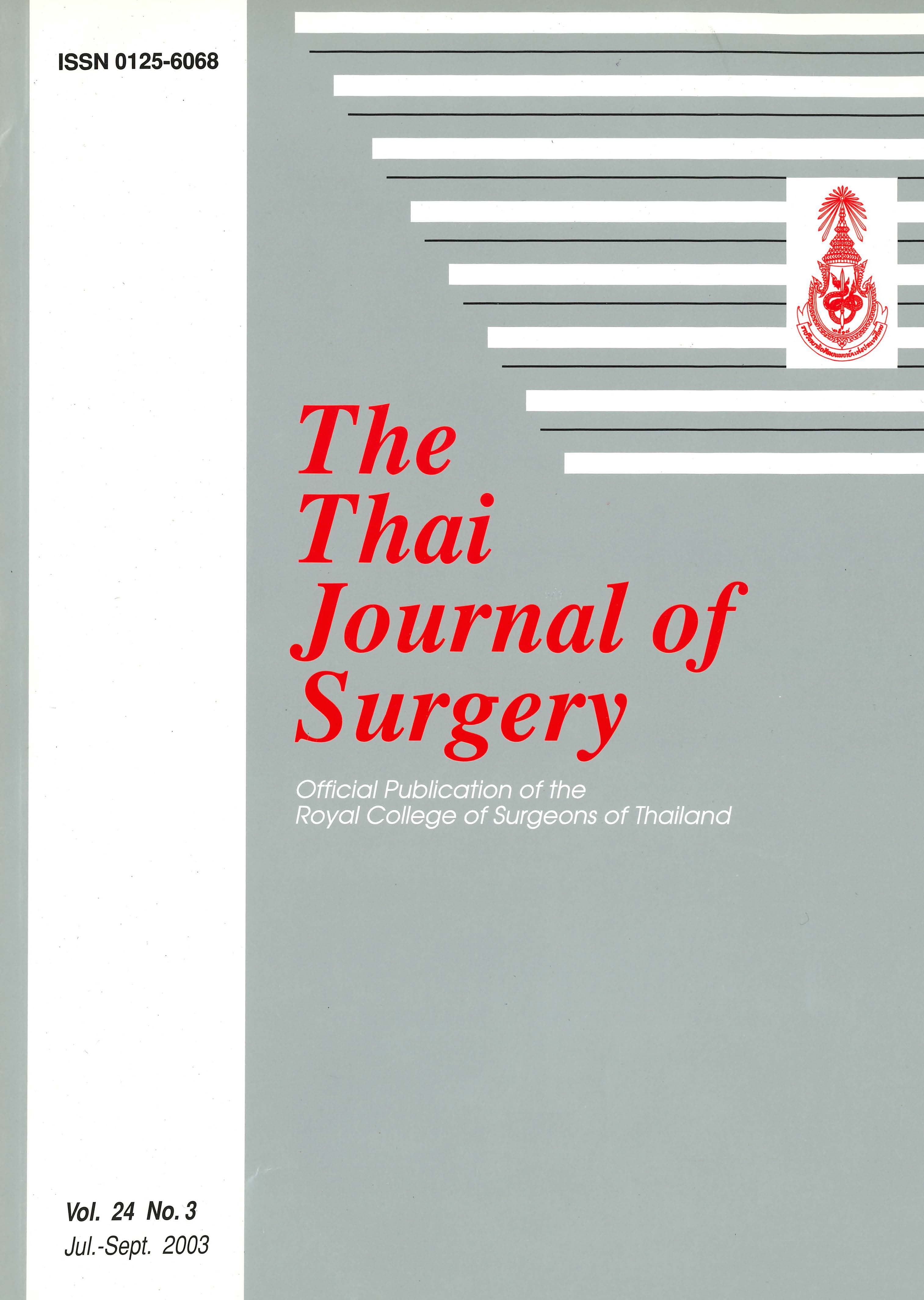Acute Appendicitis: A 5-year Review of Histopathology and Clinical Presentation
Abstract
Background: Appendicitis is one of the most common causes of acute abdominal pain. Study of diagnostic accuracy and pathological correlation aiming to reduce not only late complications but also the rate of negative appendectomy had been studied worldwide.
Patients and Methods: The diagnostic accuracy and important clinical presentations of acute appendicitis in 449 patients who underwent appendectomy in a 5-year period from 1996 to 2001 were retrospectively studied. The pathological reports were reviewed and grouped into Group I, acute appendicitis with or without perforation and Group II, no acute inflammation of appendix. Clinical information of age, sex, body temperature, and laboratory findings were analyzed by Chi-square test and p<0.05 was considered statistically significant.
Results: There were 396 cases in Group I (88.2%) and 53 cases in Group II (11.8%). Male and children less than 10 years old were the significant factors related to acute appendicitis (p<0.05). Increased neutrophilic ratio (neutrophil >75%) was significantly associated with acute appendicitis (p<0.05) especially in the range of 80-85%. There were no significant association between acute appendicitis and body temperature, WBC count, Hct, and urinary WBC.
References
2. Van Way CW(II), Murphy JR, Dunn EL, Elerding SC. A feasibility study of computer aided diagnosis in appendicitis. Surg Gynecol Obstet 1982; 155: 685-8.
3. Anderson RE, Hugander A, Thulin AJ. Diagnostic accuracy and perforation rate in appendicitis: Association with age and sex of the patient with appendectomy rate. Eur J Surg 1992; 158: 37-41.
4. Schrock TR. Acute appendicitis. In: Sleisinger MH, Fordtran JS, editors. Gastrointestinal disease: pathophysiology, diagnosis, management. 3rd ed. Philadelphia: WB Saunders;1983. p. 1268-75.
5. Condon RE. Appendicitis. In: Sabiston DB Jr, editor. Textbook of surgery. The biological basis of modern surgical practice. Philadelphia: WB Saunders; 1985. p. 967-82.
6. Lewis FR, Holcroft JW, Boey J, Dunphy JE. Appendicitis. A critical review of diagnosis and treatment in 1000 cases. Arch Surg 1975; 110: 677-83.
7. Hobson T, Rosenman LD. Acute appendicitis: when is it right or to be wrong? Am J Surg 1964; 108: 306-12.
8. Korner H, Sondenaa K, Soreide JA, Anderson E, Nysted A, Lende TH. Structured data collection improves the diagnosis of acute appendicitis. Br J Surg 1998: 85: 341-4.
9. Ng KC, Lai SW. Clinical analysis of the related factors in acute appendicitis. Yale J Biol Med 2002; 75: 41-5.
10. Anderson R, Hugander A, Thulin A, Nystrom PO, Olaison G. Indications for operation in suspected appendicitis and incidence of perforation. Br Med J 1994; 308: 107-10.
11. Wagner MJ, McKinney PW, Carpenter LJ. Does this patient have appendicitis? JAMA Nov 20, 1996; 276: 1589-94.
12. Campbell JPM, Gunn AA. Plain abdominal radiographs and acute abdominal pain. Br J Surg 1988; 75: 554-6.
13. Velanovich V. Plain abdominal radiographs and acute abdominal pain. (letter) Br J Surg 1988; 75: 1147.
14. Brazaitis MP, Darchrnan AH. The radiographic evaluation of acute abdominal pain of intestinal origin. Med Clin North Am 1993; 77:939-72.
15. Wade DS, Morrow SE, Balsara ZN, et al. Accuracy of ultrasound in the diagnosis of acute appendicitis compare with the surgeon's clinical impression. Arch Surg 1993; 128:1039-46.
16. Bouillet JL, Salah S, Fernandez F, et al. Laparoscopic procedure for suspected appendicitis: a prospective study in 283 consecutive patients. Surg Endosc 1995; 9: 957-60.
17. Zaninotto G, Rossi M, Anselmino M, et al. Laparoscopic versus conventional surgery for suspected appendicitis in women. Surg Endosc 1995; 9: 337-40.
18. Korner H, Sondenaa K, Soreide JA, Anderson E, Nysted A, Lende TH, Kjellevold KH. Incidence of acute nonperforated appendicitis: age-specific and sex-specific analysis. World J Surg 1997;21: 313-7.
19. Blair PN, Bugis PS, Turner JL, Macleod MM. Review of the pathologic diagnoses of 2,216 appendectomy specimens Am J Surg 1993; 165:618-20.
20. Blind J, Dahlgren S. The continuing challenge of the negative appendix. Acta Chir Scand 1986; 152: 623-7.
21. White JJ, Santillana M, Haller JA Jr. Intensive in hospital observation: A safe way to decrease unnecessary appendectomy. Am Surg 1975; 41: 794-8.
22. Whitworth CM, Withworth PW, Sanfillipo J, Polk HC Jr. Value of diagnostic laparoscopy in young women with possible appendicitis. Surg Gynecol Obstet 1988; 167: 187-90.
23. Chang AR. Ananalysis of the pathology of 3003 appendices. Aust NZ J Surg 1981; 51: 169-78.
24. Agafonoff S, Hawke I, Khadra M, Munings V, Notaras L, Wadhwa S, Burton R. The influence of age and gender on normal appendicectomy rates. Aust N Z J Surg 198757:843-
25. Ricci AM, Trevisani FM, Beck CW. Acute appendicitis: A 5-year review. Am Surg 1991; 57: 301-5.
26. Calder JDF, Gajraj H. Recent advance in the diagnosis and treatment of acute appendicitis. Br J Hosp Med 1995; 54:129-33
27. Wang Y, Reen DJ, Puri P. Is a histologically normal appendix following emergency appendectomy always normal? Lancet 1996; 347:1076-9.
Downloads
Published
How to Cite
Issue
Section
License
Articles must be contributed solely to The Thai Journal of Surgery and when published become the property of the Royal College of Surgeons of Thailand. The Royal College of Surgeons of Thailand reserves copyright on all published materials and such materials may not be reproduced in any form without the written permission.



